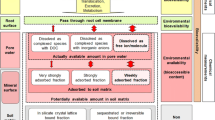Abstract
Bioavailability has been used as a key indicator in chemical risk assessment yet poorly quantified risk factor. Worldwide, the framework used to assess potentially contaminated sites is similar, and the decisions are based on threshold contaminant concentration. The uncertainty in the definition and measurement of bioavailability had limited its application to environment risk assessment and remediation. Last ten years have seen major developments in bioavailability research and acceptance. The use of bioavailability in the decision making process as one of the key variables has led to a gradual shift towards a more sophisticated risk-based approach. Now a days, many decision makers and regulatory organisations ‘more readily accept’ this concept. Bioavailability should be the underlying basis for risk assessment and setting remediation goals of those contaminated sites that pose risk to environmental and human health. This paper summarises the potential application of contaminant bioavailability and bioaccessibility to the assessment of sites affected by different contaminants, and the potential for this to be the underlying basis for sustainable risk assessment and remediation in Europe, North America and Australia over the coming decade.


Similar content being viewed by others
References
Directive 2004/35 /EC (2004) DIRECTIVE 2004/35/CE OF THE EUROPEAN PARLIAMENT AND OF THE COUNCIL. Official Journal of the European Uniion. L143/56. 30.4.2004
Ehlers LJ, Luthy RG (2003) Contaminant bioavailability in soil and sediment. Environ Sci Technol 37:295A–302A
Harmsen J (2007) Measuring bioavailability: from a scientific approach to standard methods. J Env Qual 36:1420–1428
ICRCL, ICRCL (Interdepartmental Committee on the Redevelopment of Contaminated Land ICRCL) 1987 Guidance for the assessment and redevelopment of contaminated land, ICRCL Guidance Note 59/83 (2nd Edition)
Naidu R, Rogers S, Gupta VVSR, Kookana RS, Bolan NS, Adriano D (2003) Bioavailbility of metals in the soil–plant environment and its potential role in risk assessment. In: Naidu R, Rogers S, Gupta VVSR, Kookana RS, Bolan NS, Adriano D (eds) Bioavailability and its potential role in risk assessment. Science publishers, New York, pp 21–59
Nathanail CP (2009) The role of engineering geology in risk-based land contamination management for tomorrow's cities. NUMB 22:149–158
Nathanail CP (2011a) Sustainable brownfield regeneration. In: SWARTJES F (ed) Dealing with contaminated sites: From theory towards practical application. Springer, Dordrecht, pp 1079–1104
Nathanail CP (2011b) Sustainable remediation: Quo vadis? Remediat J 21:35–44
Nathanail CP, Smith R (2007) Incorporating bioaccessibility in detailed quantitative human health risk assessments. J Environ Sci Health Part A 42:1193–1202
NEPM, NEPM (National Environment Protection Measure) 1999 Assessment of site contaminated, National Environment Protection Council, Australia
NFESC, NFESC(Naval Facilities Engineering Service Centre) (2000) User’s Guide UG-2041-ENV, Guide for incorporating bioavailability adjustments into human health and ecological risk Assessments at US Navy and Marine Corps facilities (Part 2:Technical Background Document for Assessing Metals Bioavailability). Prepared by Battelle and Exponent, Washington D.C
Ogden RC, Nathanail CP (2011) Generic human-health assessment criteria for benzo[a]pyrene at former coking works sites. CL: AIRE Res Bull RB15:1–13
Semple KT, Doick JK, Jones KC, Bureauel P, Craven A, Harms H (2004) Defining bioavailability and bioaccessibility of contaminated soil and sediments is complicated. Environ Sci Technol 2:229A–231A
Author information
Authors and Affiliations
Corresponding author
Additional information
Responsible editor: Zhihong Xu
The text below may not represent the opinions of the organisations described above.
Rights and permissions
About this article
Cite this article
Naidu, R., Channey, R., McConnell, S. et al. Towards bioavailability-based soil criteria: past, present and future perspectives. Environ Sci Pollut Res 22, 8779–8785 (2015). https://doi.org/10.1007/s11356-013-1617-x
Received:
Accepted:
Published:
Issue Date:
DOI: https://doi.org/10.1007/s11356-013-1617-x



